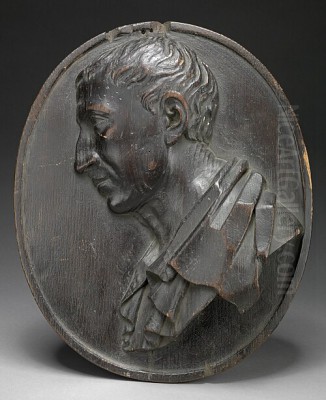
Patrick Nasmyth stands as a significant figure in early 19th-century British landscape painting. Born into an artistic dynasty in Scotland, he carved out a distinct niche for himself, primarily drawing inspiration from the Dutch masters of the 17th century. Despite facing considerable personal challenges, including a physical disability and profound deafness, Nasmyth achieved recognition and success during his lifetime, leaving behind a body of work celebrated for its meticulous detail and charming depiction of the British countryside. His life and art offer a fascinating glimpse into the artistic currents of his time, bridging the gap between earlier traditions and the burgeoning Romantic movement.
Early Life and Artistic Beginnings in Edinburgh
Patrick Nasmyth was born in Edinburgh on January 7, 1787. He was the eldest son of Alexander Nasmyth (1758-1840), a highly respected Scottish painter often regarded as the "father of Scottish landscape painting." Patrick, affectionately known as 'Peter' within the family, grew up in an environment steeped in art. His father was not only a successful landscape and portrait painter but also an architect, engineer, and influential teacher. The Nasmyth household was a hub of creativity, with Patrick's siblings also pursuing artistic or scientific endeavours. His brother, James Nasmyth, would later achieve fame as an engineer and the inventor of the steam hammer, while several of his sisters – Jane, Barbara, Margaret, Elizabeth, and Anne – became accomplished painters and art teachers in their own right.
From a young age, Patrick displayed a deep affinity for nature. He reportedly preferred exploring the countryside around Edinburgh to formal schooling, developing a keen eye for the intricacies of the natural world. His artistic inclinations were evident early on, and he received his initial training directly from his father. Alexander Nasmyth's style, itself influenced by classical landscape traditions and direct observation of nature, provided a solid foundation for Patrick's development.
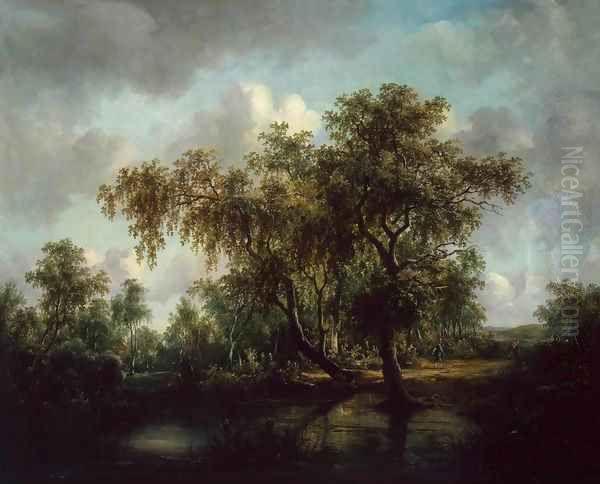
A pivotal event occurred during his youth that profoundly shaped his artistic practice. While on a sketching expedition with his father, Patrick sustained an injury to his right hand. The exact nature of the accident varies in accounts, but the result was significant damage that impaired his ability to use his dominant hand for painting. Undeterred, the young artist diligently taught himself to paint with his left hand, a remarkable feat of determination that he mastered completely. This switch did not seem to hinder the precision and detail that would become hallmarks of his style.
Adding to his physical challenges, Patrick developed profound deafness, likely resulting from illness or, as some accounts suggest, exposure to damp conditions during his outdoor excursions or perhaps related to childhood illness. This loss of hearing further isolated him in some ways but may have intensified his reliance on visual observation, sharpening his focus on the details of the landscapes he depicted. His connection to nature became almost entirely visual and tactile.
The Move to London and Stylistic Development
Around 1807 (though some sources suggest slightly later, circa 1810), Patrick Nasmyth made the significant decision to move from Edinburgh to London. This relocation marked a crucial turning point in his career, exposing him to a wider artistic milieu and allowing him to establish his independence. In London, he dedicated himself almost exclusively to landscape painting, finding a ready market for his detailed and accessible views of nature.
It was in London that Nasmyth fully developed the style for which he is best known. While his father's influence remained discernible, Patrick increasingly looked towards the Dutch landscape painters of the 17th century for inspiration. He particularly admired the works of Meindert Hobbema (1638-1709) and Jacob van Ruisdael (c. 1629-1682). Their detailed rendering of trees, rustic scenes, cloudy skies, and intricate foregrounds resonated deeply with Nasmyth's own sensibilities and his love for the tangible details of the countryside.
Nasmyth's paintings typically feature scenes of rural England and Scotland. Common subjects include winding country lanes, rustic cottages nestled amongst trees, wooden fences, streams, ponds, and detailed studies of trees and foliage. He possessed an exceptional ability to capture the specific character of different types of trees, paying close attention to their branching structures and bark textures. His foregrounds are often meticulously rendered, depicting broken ground, weeds, and rocks with careful precision.

His handling of light is generally subtle and diffused, creating a sense of calm and tranquility, though he could also depict more dramatic atmospheric effects, such as gathering storms. His skies, while carefully observed, often lack the dynamism found in the work of contemporaries like J.M.W. Turner or John Constable. Similarly, his colour palette tends towards greens, browns, and greys, applied with a delicate touch, sometimes leading critics to note a lack of strong chromatic contrast compared to the Dutch masters he admired or the bolder experiments of his British contemporaries.
The "English Hobbema"
The strong affinity between Patrick Nasmyth's work and that of Meindert Hobbema led to him being frequently referred to as the "English Hobbema" or sometimes the "Scottish Hobbema." This comparison highlights the clear stylistic debt Nasmyth owed to the Dutch Golden Age master. Like Hobbema, Nasmyth favoured intimate, enclosed rural scenes over grand, panoramic vistas. Both artists excelled at depicting woodland paths, watermills, and cottages, rendered with a high degree of detail and a focus on the textures of the natural world.
The nickname was likely intended as a compliment, acknowledging Nasmyth's technical skill and his successful emulation of a revered historical style. His meticulous finish and careful composition appealed to patrons who appreciated traditional craftsmanship and easily recognisable subject matter. His works found favour with collectors who sought pleasing, well-executed landscapes that evoked a sense of peaceful, rustic charm.
However, the comparison also implicitly points to certain limitations. While Nasmyth mastered the manner of Hobbema, his work sometimes lacks the robust vigour and atmospheric depth found in the best Dutch examples. His compositions can occasionally feel formulaic, and his colour, as noted, could be somewhat subdued. He rarely ventured into the more emotionally charged or sublime interpretations of nature that were beginning to characterize the Romantic movement in Britain, as exemplified by Turner and Constable.
Despite these nuances, the "English Hobbema" moniker accurately reflects the primary source of Nasmyth's inspiration and the specific aesthetic niche he occupied. He successfully adapted the Dutch landscape tradition to British scenery, creating a body of work that was both technically accomplished and highly popular in its day. His dedication to this style remained consistent throughout his relatively short career.
Career, Exhibitions, and Recognition
Following his move to London, Patrick Nasmyth began to establish his reputation within the city's art world. He started exhibiting his works regularly, gaining visibility among collectors and fellow artists. His debut at a major London institution appears to have been at the British Institution in 1809. He subsequently began exhibiting at the prestigious Royal Academy of Arts in 1811, and continued to show his paintings there frequently until his death.
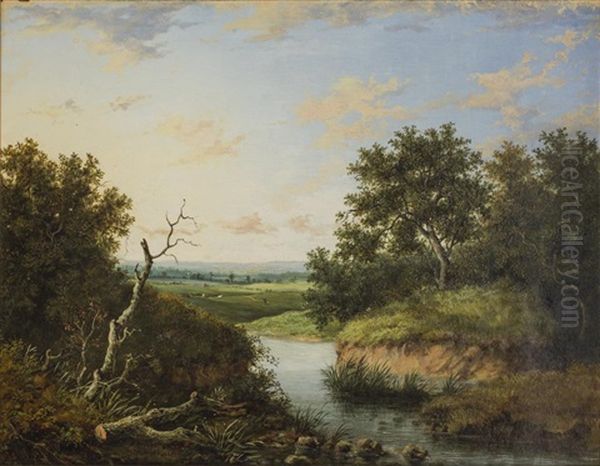
Nasmyth's detailed and accessible landscapes proved popular with the public and found a ready market. His works commanded good prices, providing him with a steady income, although biographical accounts suggest he was not always prudent with his finances. His paintings appealed to a taste for picturesque, detailed representations of the British countryside, offering an alternative to the grander historical landscapes or the increasingly experimental works of the leading Romantics.
A significant milestone in his career came in 1824 when he became one of the founding members of the Society of British Artists (SBA), now known as the Royal Society of British Artists. The SBA was established by a group of painters who felt underserved by the exhibition policies of the Royal Academy. Nasmyth exhibited frequently with the SBA at their Suffolk Street gallery, contributing a substantial number of works over the years. His involvement with the SBA underscores his standing within the London art community.
His circle of acquaintances included fellow artists and patrons. While his deafness might have limited his social interactions to some extent, he maintained connections within the art world. His close friend, William Harrison, was a notable supporter and collector of his work, frequently acquiring paintings and promoting his art. Though Patrick did not share the direct, documented friendship with the poet Robert Burns that his father Alexander enjoyed (Patrick was only nine when Burns died), the Nasmyth family connection to Burns was strong, with Alexander having painted the most famous portrait of the poet.
Representative Works and Artistic Themes
Patrick Nasmyth's oeuvre consists primarily of landscapes depicting scenes in England and Scotland. While dating his works can sometimes be challenging, several paintings are considered representative of his style and themes.
Penshurst Place, Kent: Often cited as one of his finest works, this painting showcases Nasmyth's skill in rendering architecture within a landscape setting, combined with his characteristic attention to trees and foreground detail. Penshurst Place is a historic manor house, and its inclusion reflects a common interest in picturesque historical sites.
Loch Katrine: Representing his Scottish roots, this work depicts the famous loch in the Trossachs region. It likely dates from his earlier period and demonstrates his ability to capture the specific atmosphere of the Scottish landscape, albeit rendered through his developing Dutch-influenced lens.
River Forth (1828): Another Scottish subject, this painting from relatively late in his career shows his continued engagement with the landscapes of his homeland. The depiction of the river allows for exploration of water reflections and riparian vegetation.
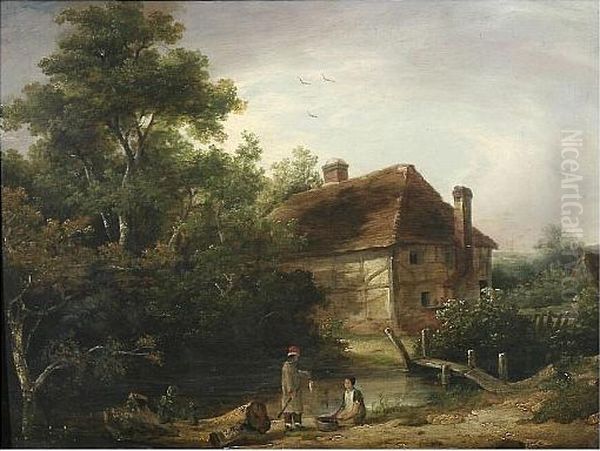
Landscape with Mill (1828): This work exemplifies a recurring theme in Nasmyth's art, directly echoing subjects favoured by Dutch masters like Hobbema. The watermill or windmill provides a focal point and adds rustic charm to the scene.
Landscape with a Pond: This painting is noted for capturing a specific atmospheric moment, possibly the lead-up to a storm. It demonstrates his ability to handle more dynamic weather conditions while retaining his typical detailed approach.
Carisbrooke Castle, Isle of Wight: Depicting another historic site, this work shows his interest in integrating recognizable landmarks into his compositions, often placing them slightly in the distance, framed by trees and countryside.
A View in Hampshire / View in Leigh Woods: Titles like these indicate his focus on specific locations, suggesting direct observation, even if the final compositions were likely studio creations adhering to his established style. These works emphasize his detailed treatment of woodland scenery.
Common threads run through these and other works: a preference for enclosed, intimate views rather than expansive panoramas; a fascination with the structure and texture of trees, foliage, and earth; the inclusion of rustic elements like cottages, fences, and mills; and a generally calm, ordered composition finished with meticulous care. His paintings offer a detailed, somewhat idealized vision of the British countryside.
Context: Nasmyth and His Contemporaries
Patrick Nasmyth worked during a period of immense dynamism and change in British landscape painting. His career overlapped with the towering figures of J.M.W. Turner (1775-1851) and John Constable (1776-1837), artists who revolutionized the genre with their innovative approaches to light, colour, atmosphere, and emotional expression. Nasmyth's art stands in contrast to their bold experimentation. While Turner explored the sublime and the dramatic potential of light and colour, and Constable sought to capture the fleeting effects of weather and the specific textures of his native Suffolk with unprecedented freshness, Nasmyth remained committed to a more traditional, detailed, and composed approach rooted in 17th-century Dutch conventions.
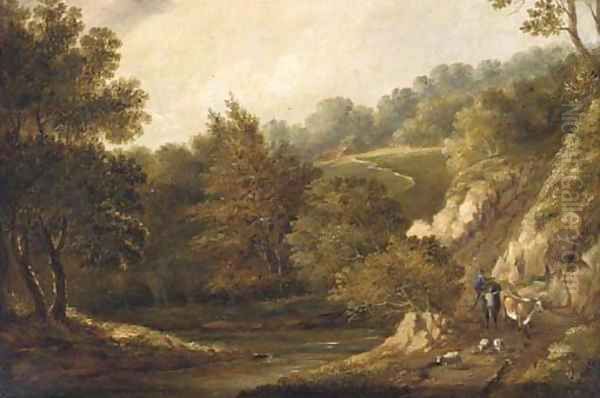
His style finds closer parallels, perhaps, with the artists of the Norwich School, such as John Crome (1768-1821) and John Sell Cotman (1782-1842). Like Nasmyth, the Norwich painters focused on depicting the local landscape with fidelity and often drew inspiration from Dutch art. However, Crome often achieved a greater breadth and atmospheric unity, while Cotman developed a distinctive style characterized by flat planes of colour and strong design. Nasmyth's meticulous detail and specific handling set him apart even from these contemporaries.
Within the Scottish context, his father Alexander Nasmyth remained a dominant figure. While Patrick inherited his father's technical skill and love for landscape, his style was generally considered less bold and varied than Alexander's, which encompassed classical landscapes, topographical views, and portraiture. Other prominent Scottish artists of the time included the portraitist Sir Henry Raeburn (1756-1823) and the genre painter Sir David Wilkie (1785-1841), who was a friend and associate of the Nasmyth family. Patrick's specialization in Dutch-inspired landscape distinguished his contribution from these figures.
Nasmyth's adherence to a detailed, somewhat conservative style ensured his popularity with certain patrons but perhaps limited his influence on the future direction of landscape painting compared to the groundbreaking work of Turner and Constable. He represents a specific, enduring taste for carefully crafted, picturesque views of nature.
Final Years and Untimely Death
Despite his professional success, Patrick Nasmyth's later life seems to have been marked by continued health problems and perhaps some degree of personal struggle. His deafness remained a significant challenge. Some biographical accounts suggest a tendency towards intemperance or imprudent living, although details are scarce.
His dedication to his art remained unwavering. He continued to sketch outdoors, seeking inspiration directly from nature. It was reportedly during one such sketching trip along the banks of the River Thames in Lambeth, London, that he caught a severe chill. This developed into pneumonia, an illness that proved fatal.
Patrick Nasmyth died in Lambeth, London, on August 17, 1831. He was only 44 years old, cutting short a career that, while already substantial, might have developed further. He left behind a significant body of work, testament to his diligence and passion for landscape painting despite the obstacles he faced.
Legacy and Influence

Patrick Nasmyth occupies a distinct and respected place in the history of British landscape painting. While not considered a major innovator on the scale of Turner or Constable, he was a highly skilled practitioner who successfully adapted the Dutch landscape tradition to British subjects, creating a style that was immensely popular during his lifetime. His nickname, the "English Hobbema," reflects his primary artistic allegiance and the specific aesthetic qualities for which his work was valued.
His paintings are admired for their meticulous detail, particularly in the rendering of trees and foreground textures, their charming depiction of rustic scenery, and their overall sense of tranquility. They offer valuable records of the English and Scottish countryside as perceived in the early 19th century, filtered through the lens of Dutch Golden Age aesthetics.
His works continue to be held in high regard and are found in numerous major public collections, including the National Gallery and Tate Britain in London, the Victoria and Albert Museum, the British Museum, the National Gallery of Scotland in Edinburgh, and many regional galleries throughout the UK and internationally. This institutional presence confirms his enduring significance.
While his direct influence on subsequent generations of artists may have been less profound than that of the leading Romantics, his work represents an important facet of British art in his era. Figures like the influential critic John Ruskin, who championed detailed observation of nature, would likely have found aspects of Nasmyth's meticulous approach commendable, even if his overall vision differed. As the most prominent landscape painter among Alexander Nasmyth's artistically gifted children, Patrick significantly contributed to the legacy of the Nasmyth family dynasty in Scottish and British art. His life story, marked by resilience in the face of disability, adds another layer of interest to his artistic achievements. He remains celebrated for his finely wrought, evocative portrayals of the landscapes he loved.